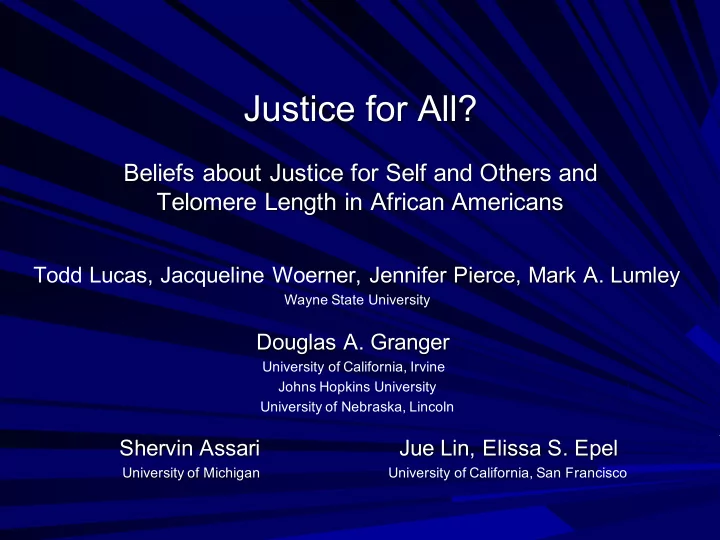

Justice for All? Beliefs about Justice for Self and Others and Telomere Length in African Americans Todd Lucas, Jacqueline Woerner, Jennifer Pierce, Mark A. Lumley Wayne State University Douglas A. Granger University of California, Irvine Johns Hopkins University University of Nebraska, Lincoln Shervin Assari Jue Lin, Elissa S. Epel University of Michigan University of California, San Francisco
What is Justice? 1. A subjective evaluation of fairness - focus on causes and consequences of perceived fairness 2. A psychosocial perception with positive health implications - Cardiovascular illness (Kivimaki et al, 2005) - Stress reactivity (Tomaka & Blascovich, 1994) - Health behavior (Lucas et al., 2008)
Is believing in justice always a positive? Emerging evidence that consistency is key. - Worldview Verification Theory (Major & Townsend, 2012) - An “accurate” rather than rote endorsement of justice African Americans are attuned to justice and injustice. - Historical and modern injustices - Injustice coping
Our questions… Are both endorsing and rejecting beliefs about justice linked to better 1. health in African Americans? - Distinguish beliefs about justice for self from beliefs about justice for others. 2. Are these beliefs linked to biological health—telomere length? - DNA at the ends of chromosomes that protect against cell degradation. - A useful indicator of biological aging and exposure to chronic adversity. (shorter TL = biologically older) - Increasingly implicated health disparities and discrimination (Chae et al., 2014; 2016).
Method and Measures Participants: - Community sample of 118 healthy African Americans. - 82 women, 36 men; 32 years old (18 to 63). Justice Beliefs: - Procedural and Distributive Justice for Self and Others (Lucas et al., 2011). - Two higher-order factors: Justice for self ( α = .92) versus others ( α = .89). Measurement of Telomere Length: - T/S ratio in dried bloodspot (Blackburn Lab). - Higher T/S ratio = longer TL (lower chronic adversity). Statistical Analysis: - Three-step hierarchical multiple regressions. - Focus on three-way interaction (Age X Self x Other).
Results Three-way interaction ( p = .038) > 47 Years
Results Three-way interaction ( p = .038) < 21 Years > 47 Years
Summary Worldview Verification Theory (Major & Townsend, 2012): - Consistency is key! Health is best protected when one’s beliefs align with one’s lived experience. - For older African Americans, positive health linked to simultaneously endorsing beliefs about justice for self and rejecting beliefs about justice for others. - This pattern not observed for younger African Americans. Developmental course?
Collaborators Rhiana Wegner Wayne State University Stefan Goetz Wayne State University Kevin Wynne Wayne State University Mercedes Hendrickson Wayne State University Edyta Debowska University of Michigan Lenwood Hayman University of Michigan, Flint Nathan Weidner Missouri S & T Eleanor Brindle University of Washington This research was supported by Award Number R21HL097191 from the National Heart, Lung, And Blood Institute and a Research Stimulation Award from the Wayne State University Office of the Vice President for Research. tlucas@med.wayne.edu
Recommend
More recommend